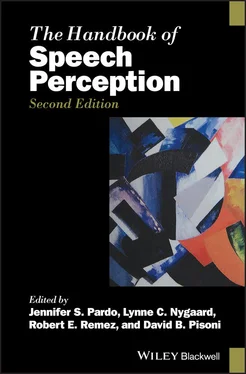Taken together, linguistic evidence suggests that features are the building blocks for the sounds of language and for characterizing its phonological processes (Jakobson, Fant, & Halle, 1951). That the speaker or hearer has internalized these properties in the daily use of language in knowing and in applying (even if unconsciously) the phonological rules of the language suggests that features are a part of the human cognitive apparatus. The next section will consider this claim by examining evidence that features are representational units in the functional architecture of language, and underlie speech perception and lexical access processes.
Feature dimensions
Speech perception
As described earlier, phonetic segments are composed of a set of features. Comparing the feature composition of segments provides a means of specifying how many features they share. It has been assumed that the more features two segments share, the more similar they are to each other. Behavioral studies support this notion (Bailey & Hahn, 2005). In particular, studies examining ratings of similarity between syllable pairs differing in consonants have shown that listeners rate pairs of syllables that are distinguished by one feature as more similar to each other than stimuli distinguished by two or more features (Greenberg & Jenkins, 1964). Discrimination studies using same/different or two auditory forced choice paradigms show that subjects take longer to discriminate and make more errors for syllable pairs distinguished by one feature (e.g. [p] and [b] differ by voicing or [p] and [t] differ by place of articulation) than stimuli distinguished by several features (e.g. [b] and [t] differ by both voicing and place of articulation) (Wickelgren, 1965; 1966; Wang & Bilger, 1973; Blumstein & Cooper, 1972). Thus, the number of features shared appears to reflect the psychological distance or space between and within phonetic segments.
It is the case that not only the number of features but the particular features present also influence speech perception. Thus, differences also emerge in the perception of single feature contrasts. In general, there is a hierarchy of performance, with increasing numbers of errors occurring for place of articulation contrasts compared to voicing contrasts, and the fewest errors occurring for manner of articulation contrasts (Miller & Nicely, 1955; Blumstein & Cooper, 1972).
Different neural responses have also been shown for features. Given a set of voiced and voiceless stop consonants and fricatives ([b d f p s t v z] in the context of the vowels [a i u]), neural regions encompassing the dorsal speech pathway have been identified that respond to the features place of articulation and to manner of articulation. In particular, Correia, Jansma, and Bonte (2015) trained a classifier to discriminate labial and alveolar place of articulation in the stop consonant syllables [pa] vs. [ta]. They demonstrated generalization in the same neural areas to fricatives distinguished by the same labial vs. alveolar contrast, [fa] vs. [sa]. Similarly, they showed generalization across manner of articulation. Training on a stop vs. fricative pair, [pa] vs. [fa], generalized to [ta] vs. [sa] (see also Guediche et al., 2018 for similar generalization results for the feature voicing).
Aphasic patients show patterns consistent with these findings. In particular, they have more difficulties discriminating minimal pair nonwords and minimal pair words that differ by a single feature compared to stimulus pairs distinguished by two features. Additionally, they have greater difficulties discriminating stimuli distinguished by place of articulation compared to voicing (Blumstein, Baker, & Goodglass, 1977).
In a seminal paper, Luce and Pisoni (1998) showed that access to an auditorily presented lexical target is affected by the word’s lexical neighborhood. A target word that is in a dense neighborhood, that is, where a large number of words share phonetic segments with the target word, is more difficult to access than a word in a sparse neighborhood, that is, where a few words share phonetic segments with the target word. These findings support a functional architecture in which the lexicon is a network where words compete for access with each other based on their phonological similarity. The more words are phonologically similar, the greater the competition, and the increased difficulty in ultimately selecting the lexical target word in word recognition.
Density is determined by computing the number of words that result from substituting, adding, or deleting a segment in the target word. Thus, these findings in themselves do not speak to whether features are a part of the lexical representation of words. However, several studies (Luce, 1986; Goldinger, Luce, & Pisoni, 1989; Luce et al., 2000) examined word recognition by investigating priming for word pairs that were maximally similar or maximally dissimilar phonologically. The metric used to determine similarity was based on subject judgments of the degree of similarity between individual consonants and vowels in the target and other words in the lexicon. Although the number of feature differences was not expressly determined, results showed that maximally similar prime target pairs resulted in slowed reaction times compared to maximally dissimilar word pairs. For example, a prime‐target pair that was maximally similar, for example, fawn [fɔn] and thumb [θəm] (see Luce et al., 2000) produced slowed reaction time latencies in a shadowing task compared to a prime‐target pair that was maximally dissimilar, for example, cheat and thumb . Comparing fawn and thumb , both consonant contrasts [f]–[θ] and [n]–[m] are distinguished by place of articulation, and [ɔ] and [ə] are distinguished by vowel height. In contrast, comparing cheat and thumb , [č]–[θ] are distinguished by manner and place of articulation, [t]–[m] are distinguished by manner, place, and voicing, and [i] and [ə] are distinguished by vowel height, tenseness, and frontness. Thus, in this case, the number of features shared (or the minimal number of features distinguished) appears to increase phonological competition between prime and target stimulus pairs.
Perhaps more compelling is evidence that shows that features play a role not only in accessing the lexical (phonemic‐phonetic) representation of words but also in influencing access to the meaning of words. In particular, the magnitude of semantic priming in a lexical decision task is influenced by the feature distance between a nonword and a prime real word that is semantically related to a target (Connine, Blasko, & Titone, 1993; Milberg, Blumstein, & Dworetzky, 1988). For example, nonwords that are distinguished from a real word by a single feature, for example, gat is distinguished from cat by the feature voicing, show a greater magnitude of priming for semantically related words, for example, dog , than nonword primes that are distinguished by two or more features, for example, wat (Milberg, Blumstein, & Dworetzky, 1988). Using the visual world paradigm, Apfelbaum, Blumstein, and McMurray (2011) showed that greater semantic priming occurred for words semantically related to a visual target as a function of the lexical density of the target. Greater semantic priming occurred for low‐density compared to high‐density word targets presumably because the greater number of competitor words in high‐density neighborhoods ultimately reduced the activation of the lexical semantic network of the target word, resulting in less semantic priming compared to target words from low‐density neighborhoods.
It is always possible that feature effects for adults could reflect learning and experience with the language rather than fundamental, intrinsic properties of language. However, compelling evidence that features serve as the building blocks for phonological and ultimately word representations comes from the developmental literature. In an auditory word discrimination task, Gerken, Murphy, and Aslin (1995) showed that three‐ to four‐year‐old children were sensitive to the degree of mismatch between a target word and a nonword that varied in the extent of feature overlap. Either the stimuli differed by a single feature segment or by two feature segments. Such graded sensitivity to feature attributes in accessing words was shown in even younger children. Using a preference looking paradigm, White and Morgan (2008) presented 19‐month‐old toddlers with a visual presentation of two objects corresponding to a familiar word or an unfamiliar word. When an auditory stimulus was presented that named the familiar object or was one‐ (place), two‐ (place and voicing), or three‐feature (place, voicing, and manner) mispronunciations from the initial consonant of the familiar object, the toddlers showed, as do adults (White et al., 2013), graded sensitivity to the degree of mismatch, with progressively fewer looks to the familiar object as the feature distance between the correctly named familiar object and the mispronounced stimuli increased.
Читать дальше








![О Генри - Справочник Гименея [The Handbook of Hymen]](/books/407356/o-genri-spravochnik-gimeneya-the-handbook-of-hymen-thumb.webp)



